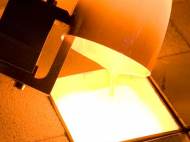Robotic system enables faster and automated glass development
 Aside the difference in coloration, a layman might think every glass material is the same, but there is more than it meets the eye in this transparent material. Glass can consist of up to 60 different elements, and experts are constantly creating glass with properties required in some application. Researchers of the Fraunhofer Institute for Silicate Research ISC in Würzburg have developed a robot that performs this automatically.
Aside the difference in coloration, a layman might think every glass material is the same, but there is more than it meets the eye in this transparent material. Glass can consist of up to 60 different elements, and experts are constantly creating glass with properties required in some application. Researchers of the Fraunhofer Institute for Silicate Research ISC in Würzburg have developed a robot that performs this automatically.
“It needs only 24 hours to process 16 samples”, said Dr. Martin Kilo, manager of the expert group for glass and high-temperature materials at the Fraunhofer ISC. “For this reason we are able to develop glass elements more cost-effectively than previously, by up to 50 percent.”
This method is much faster compared to current practice where glass samples are produced and tested. For example, one employee needs approximately two weeks to process 16 samples.
The robot puts a mixing cup on a scale and combines a certain amount of 14 powders. After a desired combination is poured in, the cup is closed and the ingredients are mixed by shaking. The robot arm then grabs a crucible (a container used for metal, glass, and pigment production), puts it onto the scale, fills it with a certain amount of the mixed powder and puts the crucible into one of the five available furnaces.
These steps are repeated several times, since the powder shrinks during the melting process and gases build up when the powder is heated. At the end of the process, the furnace heats the fully filled crucible to a higher temperature, causing the gas bubbles in the glass to rise to the surface. Once the glass is viscous, the robot arm removes the crucible, pours the glass into a new mould and places it in a stress-relieving furnace. Here, the glass cools down to a room temperature in a slow and controlled manner.
Looking through two measurement windows, the shade the sample projects in a backlight test system is recorded by a CCD camera to be analyzed by the thermo-optical measurement principle. The changes in the contour provide readings regarding such as sample volume, hemisphere point and wetting angle.
The test unit measures how viscous the melt is, and if and how it crystallizes and wets metals, and it can also determine and record the ability of the glass to conduct heat. The test unit can also be used independently of the glass screening unit.
For the first time ever, a robot takes on the task of developing new types of glass and examining their characteristics. Researchers will introduce this robot at the productronica trade fair to be held in Munich, Germany, from November 15 – 18, 2011.









Leave your response!